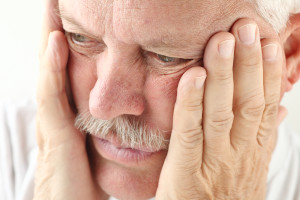 Temporomandibular joint (TMJ) dysfunction can refer to any problem and/or pain affecting the joint (and its attached muscles) that connects the lower jaw to the skull. Many problems may lead to TMJ problems, such as direct trauma. It is thought that tension or injury to head/neck muscles that attach at and near the TMJ may lead to a number of these dysfunctions.
Temporomandibular joint (TMJ) dysfunction can refer to any problem and/or pain affecting the joint (and its attached muscles) that connects the lower jaw to the skull. Many problems may lead to TMJ problems, such as direct trauma. It is thought that tension or injury to head/neck muscles that attach at and near the TMJ may lead to a number of these dysfunctions.
Non-painful issues include joint clicking, popping or slipping sounds/sensations. Pain related to the TMJ may occur at the joint, head, neck or face. Those with or without pain may not be able open the jaw (trismus), causing difficulty eating and, occasionally, speaking. This fairly common condition usually starts between 20 and 40 years of age, and is more common in women than men.
Conventional medicine’s treatment options include devices like mouth splints, stress reduction and analgesic medications. Although surgery for this problem is not currently favored, there are some new approaches involving “sculpting” the biting surfaces. [1]
Acupuncture can help relieve pain and dysfunction of the TMJ. Additionally, Trigger Point Injection Therapy of the neck and upper back region reduces the muscle tension possibly causing this problem. Neurological Scalp Acupuncture, Chinese Herbal Medicine, cupping and gua sha are useful adjuncts. [2] [3] [4]
Learn more about Temporomandibular Joint (TMJ) Dysfunction
X
These brief overviews of conditions represent distillations of basic and current medical reviews from the following sources:
[1] Conventional Medical Sources
“Harrison’s Principles of Internal Medicine: Volumes 1 and 2, 18th Edition”. Dan Longo Anthony Fauci, Dennis Kasper, Stephen Hauser, J. Jameson, Joseph Loscalzo. McGraw-Hill Professional; (July, 2011)
Medscape eMedicine Physician’s online resource. Various review articles accessed June 2013:
Migraine Headache
Jasvinder Chawla, MD, MBA Chief of Neurology, Hines Veterans Affairs Hospital; Associate Professor of Neurology, Loyola University Medical Center
Tension Headache, Cluster Headache
Michelle Blanda, MD Chair, Department of Emergency Medicine, Summa Health System Akron City/St Thomas Hospital; Professor of Emergency Medicine, Northeastern Ohio Universities College of Medicine
Temopromandibular Joint Disorders
Charles F Guardia III, MD Instructor in Neurology, Department of Neurology, Dartmouth Hitchcock Medical Center, Geisel School of Medicine at Dartmouth
Trigeminal Neuralgia
Manish K Singh, MD Assistant Professor, Department of Neurology, Teaching Faculty for Pain Management and Neurology Residency Program, Hahnemann University Hospital, Drexel College of Medicine; Medical Director, Neurology and Pain Management, Jersey Institute of Neuroscience
[2], [3] “Acupuncture Energetics: A Clinical Approach for Physicians”. Joseph M. Helms. Medical Acupuncture Publishers; 1st Edition. (1995)
- “Foundations of Chinese Medicine: A Comprehensive Text for Acupuncturists and Herbalists”. Giovanni Maciocia. Churchill Livingstone; 2 Edition (July, 2005).
- “Diagnosis in Chinese Medicine: A Comprehensive Guide”. Giovanni Maciocia. Churchill Livingstone; 1st Edition (January, 2004).
[4] “Chinese Scalp Acupuncture”. Jason Ji-shun Hao, Linda Ling-zhi Hao and Honora Lee Wolfe. Blue Poppy Press; 1st Edition. (November, 2011)
